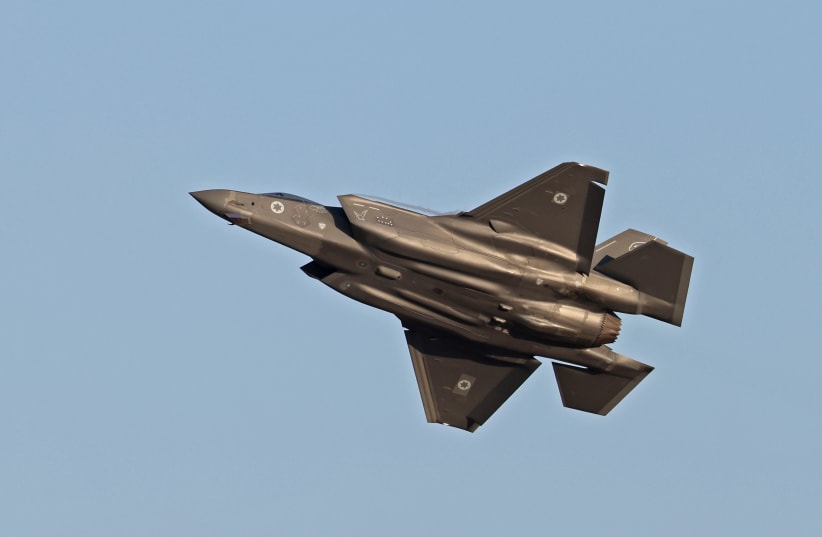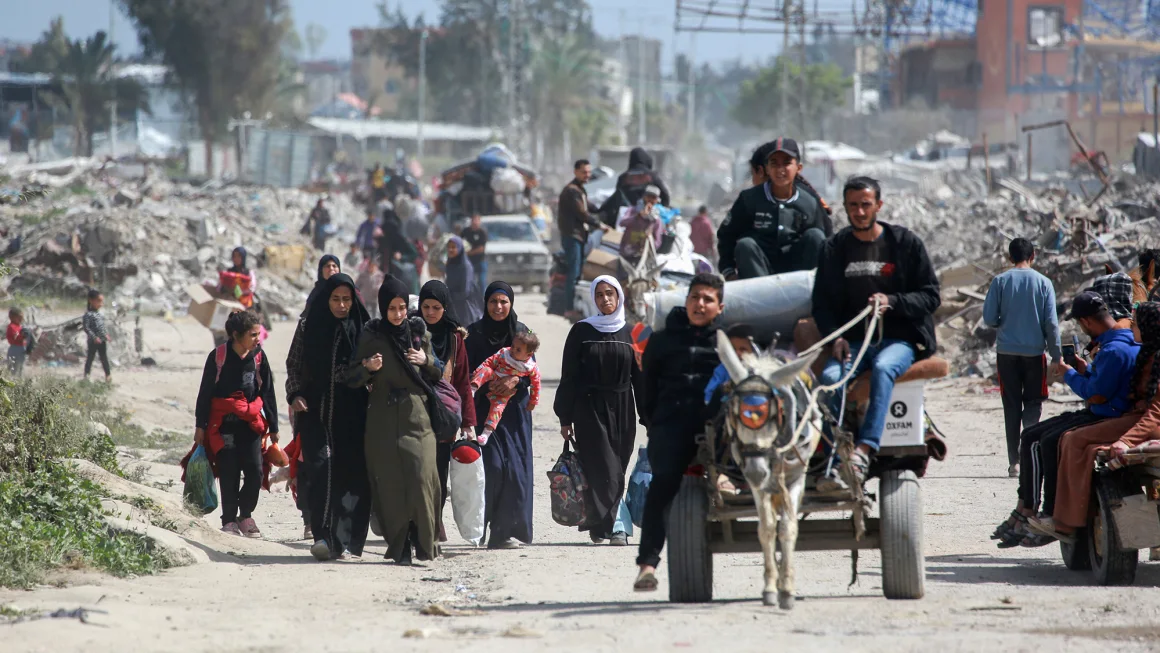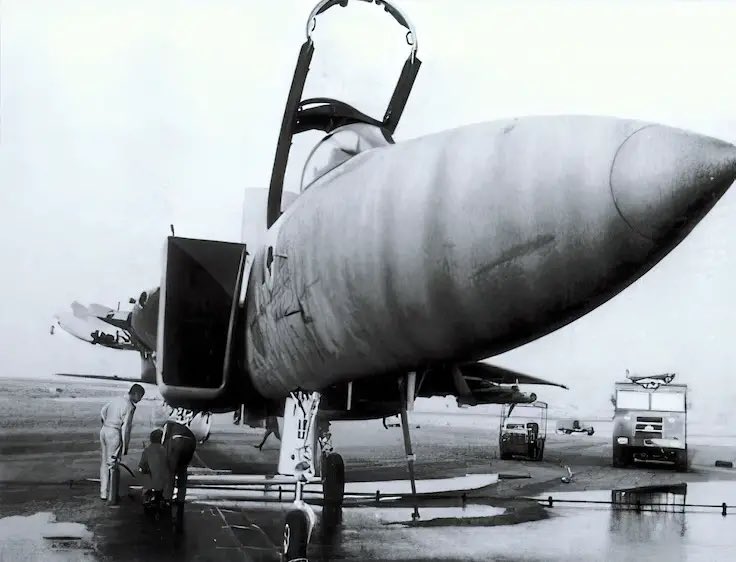Foreign
Behind the scenes of Israeli attack: Over 100 aircraft and a 2,000 km journey to Iran

The IDF confirmed the operation focused strictly on military targets, steering clear of nuclear and oil facilities to prevent wider conflict escalation.

Over 100 planes were involved in the attack on Iran on Saturday, including the cutting-edge F-35.

Israel’s preliminary strike on radar targets in Syria was aimed at “blinding” Iran’s capabilities, quickly escalating into an offensive targeting Tehran and Karaj, Iran’s capital and another strategic location.
The IDF confirmed the operation focused strictly on military targets, steering clear of nuclear and oil facilities to prevent wider conflict escalation. High alert remains as Israel anticipates potential retaliation, not only from Iran.
This large-scale assault involved over 100 aircraft, including F-35 “Adir” stealth fighters, traveling approximately 2,000 kilometers. According to foreign reports, strikes focused on Tehran and Karaj, with the IDF stating that each wave targeted military sites exclusively, mitigating further conflict risks.
An operation of this scope likely began with initial waves attacking radar and air defense systems, clearing the path for subsequent strikes on military bases. Earlier, a coordinated strike in Syria neutralized similar threats, preventing Iran from building situational awareness of Israel’s plans.

IDF Chief of Staff, Lt. Gen. Herzi Halevi, is currently leading the operation in Iran from the Air Force bunker at the Kirya, alongside Maj. Gen. Tomer Bar, the Air Force Commander, October, 26, 2024. (credit: IDF SPOKESPERSON UNIT)
Using heavy munitions, long-distance strikes such as these require significant refueling capabilities and the 669 Rescue Unit on high alert.
The IDF now closely monitors potential responses from Iran, Iraq, Yemen, Syria, and Lebanon, preparing for a spectrum of possible retaliatory actions.
Leading the operation
Defense Minister Yoav Gallant and Chief of Staff Lt. Gen. Herzi Halevi remain stationed at the Kirya base in Tel Aviv. A senior Israeli official reported that the Security Cabinet authorized the strike in a phone conference last night.
“The IDF is fully prepared for both offensive and defensive maneuvers, monitoring Iran and its proxies closely,” said IDF Spokesperson R.-Adm. Daniel Hagari. He confirmed no changes in Home Front Command guidelines for now. “We urge continued vigilance and adherence to Home Front Command instructions, with updates to follow immediately on any changes.”
The White House backed Israel’s actions, stating, “Israel’s precise strikes on Iranian military targets align with its right to self-defense and respond to the Iranian missile attack on October 1.” US officials verified that Israel provided notice of the timing a few hours before the operation.
“President Biden was briefed on the Israeli strike in Iran and is closely monitoring developments,” a senior US official said.

Foreign
Dead Nigerians, Africans, others without will may lose unclaimed estates in UK

Hundreds of unclaimed estates reveal untold stories of African migration, wealth, and family ties left behind.
Thousands of people die every year in the United Kingdom without leaving a will or identifying next of kin, and among them are many Nigerians and other Africans whose estates—ranging from property to savings—remain unclaimed.
The UK government’s latest list of unclaimed estates, updated daily, includes over 170 entries connected to African-born individuals, with Nigerians making up a significant portion of the cases.

A Legacy Lost
For many migrants, the UK became a home away from home—a land of opportunity where they built wealth, purchased property, and created a life.

However, the absence of a will often results in their assets being classified as “bona vacantia” (ownerless goods), leaving them to the custody of the Crown.
Families back in Africa are frequently unaware of these estates, leading to a permanent loss of assets.
Cases like that of Adenike Adebiyi, who passed away in Hackney, London, in 2004, or Solomon Adekanmibi, who died in Colchester, Essex, in 2021, highlight the consequences of dying intestate.
With no identified next of kin or missing documentation, their estates remain unclaimed, and their legacies risk being forgotten.
Why It Matters
This phenomenon underscores a critical issue: many African families are unaware of their relatives’ financial situations abroad.
Migration often disrupts communication, and without clear documentation, the wealth built overseas remains beyond reach.
The loss isn’t just financial—it’s deeply cultural and emotional. Unclaimed estates represent untold family histories, connections, and the struggles of migrants who built their lives in the diaspora.
The Challenges
Lack of Awareness:
Most families in Nigeria and other African countries are unaware of their relatives’ estates abroad or how to access them.
Genealogical Gaps:
The information provided in official records is often incomplete. For example, many entries in the UK unclaimed estates list lack detailed family history or next-of-kin information.
Cultural Hesitations:
In many African cultures, discussing death and wills is considered taboo, leading to reluctance in planning for asset distribution.
A Call to Action
African governments, community organizations, and legal professionals need to raise awareness about this issue.
Here’s what can be done:
Encouraging Will Writing: Migrants in the diaspora should be educated about the importance of drafting wills to protect their assets.
Genealogical Support: Families in Africa can be assisted in tracing unclaimed estates through local or international partnerships.
Public Awareness Campaigns: Social and traditional media can highlight the importance of estate planning and share resources for families.
How to Check the List
The UK government maintains a public Unclaimed Estates List that is updated daily.
Families can search the list by name, place of birth, or other identifiers to check for potential claims.
Final Thoughts
For many Nigerians and Africans in the UK, their unclaimed estates represent more than just wealth—it’s a story of migration, resilience, and identity.
By addressing this growing issue, families can reclaim their heritage, and the legacy of those who journeyed to the diaspora need not be forgotten.
Here is the latest daily update as of March 24, 2025. Check the list

Foreign
Israel approves controversial proposal to facilitate emigration of Palestinians from Gaza

Israel’s security cabinet has approved a controversial proposal to facilitate Palestinian emigration from Gaza, a move critics warn could amount to ethnic cleansing.

Israeli Finance Minister Bezalel Smotrich on Sunday said the security cabinet approved the proposal by Defense Minister Israel Katz to organize “a voluntary transfer for Gaza residents who express interest in moving to third countries, in accordance with Israeli and international law, and following the vision of US President Donald Trump.”

The decision marks a remarkable endorsement of a plan once considered a far-right fantasy – and comes despite the prime minister’s earlier pledge not to permanently displace Gaza’s civilian population.
Critics have said that any mass displacement of Gazans in the midst of a devastating war would amount to ethnic cleansing, an act associated with war crimes and crimes against humanity under international law. Israeli officials have countered that emigration would be voluntary and in line with international legal standards.
But aid groups argue that Israel’s war has made life in Gaza nearly impossible. Martin Griffiths, the United Nations’ top emergency relief official, has called the enclave “uninhabitable,” saying its people are “witnessing daily threats to their very existence.”
The Israeli approval would establish an administration within the defense ministry “to prepare and facilitate the safe and controlled movement of Gaza residents who wish to voluntarily move to third countries,” according to a statement from the defense ministry.
Its work would include “establishing movement routes, pedestrian checks at designated crossings in the Gaza Strip,” and infrastructure to enable people to leave.
Israeli officials have presented the plan as a fulfillment of a desire by Trump to take over Gaza, expel its Palestinian population to neighboring countries and turn it into a Middle Eastern “riviera.”
The Palestinian Authority’s Minister of State for Foreign Affairs Varsen Aghabekian Shaheen told CNN’s Becky Anderson last month that Palestinians “are steadfast to stay in their land and will not move.”
Trump’s ‘vision’
Katz said Sunday that Israel is using “all means to implement the vision of the US president,” according to the defense ministry statement.
This month, Trump appeared to backtrack on his comments about displacing Palestinians, telling reporters that “nobody is expelling any Palestinians.” Steve Witkoff, the US special envoy to the Middle East, said last month that the US initiative to rebuild Gaza won’t necessarily amount to an “eviction plan” and that it was designed to “shake up everybody’s thinking.”
Last year, Israeli Prime Minister Benjamin Netanyahu said his country had no intention to displace Palestinians or occupy Gaza.
Related articleTrump says ‘nobody is expelling Palestinians,’ weeks after saying they should be moved to Arab states
“I want to make a few points absolutely clear: Israel has no intention of permanently occupying Gaza or displacing its civilian population,” Netanyahu said in a video statement in January 2024.
Trump’s proposal has, however, brought the idea further into the mainstream, with Israeli politicians now openly discussing mass emigration of Gazans as a solution to the war. And Katz last week said that Israel may maintain a permanent presence in the enclave.
Israeli rights group Peace Now criticized the plan, saying “the establishment of the administration to expel Palestinians from Gaza is one of the stupidest moves by a government that has lost all direction and logical thinking.”
The prospect has also drawn sharp rebuke from Arab leaders, especially Egypt and Jordan, who would be expected to absorb the large number of expelled Palestinians. Experts have also warned that displacing Palestinians would further destabilize the region and threaten the security of neighboring states.
Smotrich said Sunday that the security cabinet also approved the expansion of Jewish settlements in the occupied West Bank, noting that 13 areas in the West Bank would be split from existing settlements and would be recognized as independent settlements.
“Instead of hiding and apologizing – we are raising the flag, building, and settling. This is another important step on the path to actual sovereignty in Judea and Samaria,” he said, using the name by which Israelis refer to the West Bank.
The Yesha Council, an umbrella body representing Jewish settlements, said that as of January 2024, there were 150 settlements in the West Bank.
It said that the decision exposes a “long-standing lie that (Israel) does not establish new settlements, but only ‘neighborhoods’ of existing settlements” and that it is “another nail in the coffin that the Government of Israel is preparing for the only chance for a future of peace and security.”
A statement sent by Smotrich’s office said the move comes against “the backdrop of the approval of tens of thousands of housing units in Judea and Samaria and represents another significant step in the process of normalizing and regulating the settlement.”
Smotrich and other right-wing ministers have been pushing an aggressive expansion of settlements on the path to declaring Israeli sovereignty over the West Bank, which would be in defiance of international law and UN Security Council resolutions.
Israel says it will maintain ‘permanent’ presence in Gaza unless hostages are freed

Foreign
F-15 Eagle: How Israel’s combat jet defied gravity, flying, llanding with just one wing after mid-air collision

On a sweltering day over Israel’s Negev Desert, an Israeli Air Force (IAF) F-15D Eagle, piloted by Captain Zivi Nedivi, collided mid-air with an A-4 Skyhawk during a training mission.

The crash obliterated the Skyhawk, forcing its pilot to eject while stripping the F-15 of its right wing.

In an astonishing turn of events, Nedivi piloted the damaged jet back to Ramon Airbase and landed it safely, defying the limits of aviation science and etching a remarkable tale into military history.
Collision In The Desert Sky
The incident happened on May 1, 1983, during a routine exercise focused on aerial combat practice. Nedivi, stationed in the front cockpit of the two-seat F-15D, was joined by an experienced instructor, Yehoar Gal, in the rear.
The mission, an “airfield defense” exercise, included several aircraft, among them an A-4N Skyhawk, a compact jet used for training and support tasks. The F-15s were playing the role of defenders, and the A-4s were serving as aggressors.
Mid-flight, the F-15, and Skyhawk collided—likely due to a misjudged maneuver—sending the Skyhawk into a fatal breakup. Its pilot parachuted to the desert below as fragments scattered across the landscape.
The impact inside the F-15 was immediate and severe. Alarms sounded, and the jet shook violently, its controls responding unevenly.
F-15D Sky Blazer (Via X)
Nedivi, unaware that the right wing had been completely severed, faced a critical decision. Given the damage, ejecting would have been the expected choice, but with the instructor’s calm direction, he opted to stay with the aircraft.
Pushing the twin Pratt & Whitney F100 engines to full power, he accelerated to roughly 260 knots—double the standard landing speed—to prevent the jet from plummeting.
Are Israel’s GPS Attacks Impacting India As It Records 465 Incidents Of “GPS Spoofing” In Last 15 Months?
A Precarious Journey Back
The return to Ramon Airbase demanded intense focus. Without its right wing, the F-15 struggled to maintain balance, its movements unpredictable.
Nedivi, guided by the instructor’s steady input, kept the aircraft on course across the sprawling Negev. As the runway came into view, he prepared for a high-speed landing. The jet hit the tarmac with force, skidding until Nedivi activated the arresting hook, which caught a cable and halted the aircraft abruptly.
Stepping onto the runway, Nedivi and his instructor confronted the shocking sight: the right wing was gone, leaving a rough, torn edge along the fuselage. Ground crews, arriving moments later, shared their amazement. The question lingered: how did this jet, stripped of a vital component, manage to fly and land?
Nuke Race Heats-Up! Over Half-A-Dozen Nations Could Go Nuclear As Trump Dithers On Security Promises
Roots Of A Rugged Fighter
The F-15’s survival owes much to its robust design, which was born from a pressing need in the late 1960s. During the Vietnam War, the U.S. Air Force found its F-4 Phantom II outmatched by nimble Soviet MiG fighters, sparking a demand for a superior aircraft.
McDonnell Douglas answered with the F-15 Eagle, which first took flight on July 27, 1972. Powered by two F100 engines, each delivering over 23,000 pounds of thrust, the jet could exceed Mach 2.5 and climb beyond 65,000 feet.
Its frame, a mix of aluminum, titanium, and steel, was built to endure significant stress. A wide fuselage supported stability and housed advanced radar and weapon systems.
The F-15 is also a high-wing aircraft. Entering service in 1976, it became a cornerstone of U.S. air power. Israel acquired its first units that same year, recognizing its potential in a volatile region.
By 1983, the IAF had shown the jet’s capabilities in the 1982 Lebanon War, downing 33 Syrian aircraft without a single loss. This particular aircraft, known as “Baz” (or Falcon) 957, had scored four kills against MiGs a year prior.
The Israeli Air Force clearly still values the F-15. Despite its age, the platform’s proven track record and ongoing upgrades have solidified its place as a critical asset. In November 2024, Israel finalized a US$5.2 billion deal with Boeing to acquire 25 new F-15EX aircraft, the most advanced variant of the Eagle.
The Man at the Helm
Captain Zivi Nedivi brought a wealth of expertise to the cockpit. Born in Israel in the late 1950s, he grew up in a country where air defense was a constant priority.
Joining the IAF as a young officer, he advanced through a demanding training program, starting with basic aircraft before mastering fighters like the F-15.
By the early 1980s, he had built a solid record, with extensive flight hours and operational missions under his belt.
The Israeli Air Force F-15D Baz #957 was involved in the incident, seen here in 2011- Wikipedia.
Known for his composed approach and technical skill, Nedivi was well-suited for the training role he held that day. His preparation—years of simulator work and real-world flights—equipped him to handle the unexpected, a capability that proved decisive in the crisis.
Nedivi, though technically the student, was senior in rank to his instructor and opted not to eject as he regained some degree of control, still unaware of the full extent of the damage.
“I probably would have ejected if I knew what had happened,” Nedivi reflected later.
According to Nedivi’s recollection, the F-15D likely flew approximately 10 miles (16 kilometers) after losing its wing.
Engineering Marvel
Engineers later analyzed how the F-15 stayed aloft. The wide, flat fuselage, designed for maneuverability and equipment capacity, provided enough lift to partially compensate for the lost wing, essentially functioning as a lifting body. The center of the lift was also changed dramatically but still allowed for a controlled flight.
The powerful engines sustained the high speed needed to avoid a stall while the airframe’s durability absorbed the unusual strain. Although constructed to withstand combat damage, the F-15 had not been tested for such an extreme condition.
McDonnell Douglas engineers noted that this outcome exceeded their expectations, revealing the jet’s remarkable resilience.
The approximate weight of the F-15 is 45,000 pounds, showing the amount of lift needed to keep it airborne. “I don’t think any other aircraft could have taken that amount of damage or had that portion of its flight surfaces removed and continue to bring us home safely,” Nedivi said.
After the landing, the F-15 was swiftly repaired at Ramon Airbase. Within eight weeks, technicians replaced the missing wing and restored the aircraft’s systems, returning it to service within the IAF fleet.
This quick recovery showed Israel’s emphasis on operational readiness and the F-15’s practical design, which allowed for efficient maintenance.
The IAF logged the incident as an anomaly, opting not to revise its training practices based on the event. McDonnell Douglas cited the occurrence in technical reviews, emphasizing the jet’s structural strength, though it did not alter the aircraft’s design.
The F-15 continued to evolve, with later versions incorporating updated electronics and armaments, maintaining its role in modern air forces.
Nedivi and the IAF’s Response
For Nedivi, the incident became a notable chapter in his career, though he resumed flying without public fanfare. The IAF, focused on mission continuity, rarely highlights individual achievements, and this was no exception.
The instructor received quiet recognition for his role in maintaining control, with instructions relating to airspeed and engine power. The collision was attributed to an error during the exercise, with no repercussions for those involved.
The event rippled through aviation circles, sparking interest among military professionals. The F-15 remained a vital asset for Israel, while the U.S. advanced the jet with models like the F-15EX, still operational as of March 2025.
The F-15’s creation was driven by Cold War dynamics, particularly the Soviet MiG-25’s emergence as a high-speed threat. Its powerful engines and sturdy structure were engineered to meet such challenges, providing the foundation for Nedivi’s survival.
The wide fuselage, a practical choice for stability, unexpectedly played a critical role, offering lift when conventional flight was impossible.
Nedivi’s success hinged on his thorough preparation.
The IAF’s training—rigorous simulator sessions and extensive flight experience—readied him for emergencies. His ability to adapt, bolstered by the instructor’s guidance, ensured the jet’s safe return, highlighting the value of disciplined preparation.
Penned By: Mohd. Asif Khan, ET Desk
Mail us at: editor (at) eurasiantimes.com
Previous articleAre Israel’s GPS Attacks Impacting India As It Records 465 Incidents Of “GPS Spoofing” In Last 15 Months?
Next articleCornerstone Of Next-Gen Drone Warfare — AI Enabled Machine Vision Drones Set To “Rule The Roost” In Warzone
Sumit Ahlawat
Sumit Ahlawat has over a decade of experience in news media. He has worked with Press Trust of India, Times Now, Zee News, Economic Times, and Microsoft News. He holds a Master’s Degree in International Media and Modern History from The University of Sheffield, UK. He can be reached at ahlawat.sumit85 (at) gmail.com

-

 News1 week ago
News1 week agoBill to establish National Cashew Production and Research Institute in Kogi passes first reading in Senate
-

 News1 week ago
News1 week agoReport of attack on Wike’s Port Harcourt residence false, misleading – Police
-

 News1 week ago
News1 week agoShehu Sani debunks Governor Uba Sani’s alleged diversion of LG funds, challenges El-Rufai to publicly tender evidence
-

 News1 week ago
News1 week agoPlateau gov’t expresses concern over violence in Shendam LGA, calls for calm
-

 Sports1 week ago
Sports1 week agoMerino gives Arsenal win over Chelsea
-

 Politics6 days ago
Politics6 days agoOpposition leaders announce coalition to challenge Tinubu in 2027
-

 Interview1 week ago
Interview1 week agoSenators Natasha-Akpabio saga should have been resolved privately – Rev. Mrs Emeribe
-

 News1 week ago
News1 week agoNatasha uncovers arrest plot after reported Akpabio to IPU in New York





















